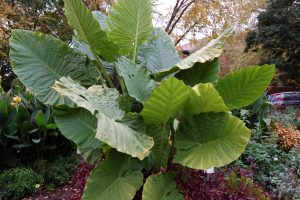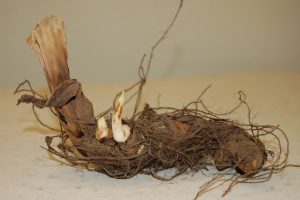While fall is the time to plant hardy bulbs, it is also the time to dig up tender perennials to save for next year’s garden. Some flowering perennials are not hardy in our climate but produce an underground bulb, root or other structure that can be lifted from the soil and stored overwinter. The most common garden plants in this category include gladiolus, caladium, tuberous begonias, canna and dahlia. Although these plants are all collectively called tender perennials, each is best handled a bit differently.
A number of tropical plants grown for foliage rather than flowers are collectively called elephant ears by many gardeners. Caladiums are grown for their brightly colored leaves, while Alocasia and Colocasia are grown for huge, waxy green leaves that are often highlighted with white, purple or another contrasting color. All of the elephant ear species are quite sensitive to cold temperatures and should be dug just before, or soon after, light frost. Cut the stems back to 3 to 6 inches, then place the tubers in a warm location for seven to10 days to remove surface moisture. To prevent excessive drying in storage, pack the tubers between layers of dry vermiculite, peat moss, sawdust or similar material in a strong box. Store at 50-60 degrees F (closer to 60 for Caladiums).
Tuberous begonias should also be dug just before frost. Cut the tops back to 2 inches and air dry the roots for two to three weeks in a warm location. Then, store in boxes, as you would caladiums, but decrease the temperature to about 45-50 degrees F.
Dahlias should be cut back to about 3-4 inches after the first light frost. Then, carefully lift the plants, leaving as much soil attached as possible to prevent breaking the fleshy roots. Because they are so susceptible to drying, dahlia roots should be air-dried for only a few hours or so. Then, pack in boxes, as you would caladiums, and store at 35-40 degrees F.
Gladiolus produces underground, compressed-stem structures called corms, which should be dug when the foliage just begins to fade, usually after a frost. Use a spading fork to carefully lift the plants, and save any of the miniature corms (called cormels). If planted next year, these cormels will grow larger and eventually reach a size that will support flowers as well as foliage.
The corms should be cured before storing to help prevent disease from developing. Cure the corms for two to four weeks in a warm (about 75-80 degrees F) room where air can circulate around the corms. Once cured, the corms should be stored dry in a cold, but non-freezing, location, about 35-40 degrees F. Old nylon stockings or onion bags hung from the wall allow good air circulation throughout storage.
Canna need not be dug until after a hard frost. Cut the tops back to 4 inches, lift with a spading fork and air dry in a warm spot for one to two weeks. Canna roots do not require covering; they can simply be placed in shallow boxes. The roots are best stored at 45-50 degrees F.



